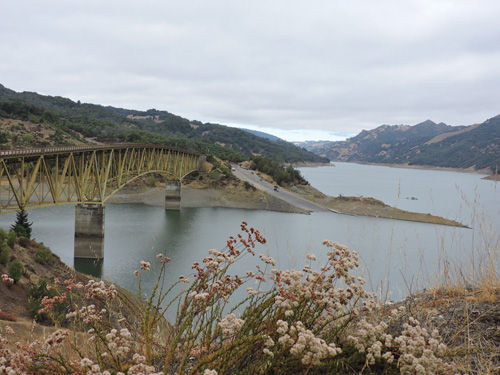
Exploring monitoring methods for lakes water supply
The Sonoma County Water Agency (SCWA) has recently entered into a partnership with the Center for Western Weather and Water Extremes (CW3E) with the intent to conduct research that would advance the knowledge of atmospheric rivers’ role in filling Lake Mendocino and offer more informed predictions on when to retain or release water.
Atmospheric rivers are narrow bands of water vapor that provide around half of the major rainfall in the Russian River watershed. While difficult to predict, these weather events play a significant role in the development of both droughts and floods in the area.
“We’re not only looking at flooding, which is a big issue, but also when droughts might occur,” said Sonoma County Water Agency Chief Engineer Jay Jasperse. “How can we better manage our reservoirs to function better on a flood-control basis, as well as a water supply basis, with the extreme variability that we receive in the region.”
Under the right conditions, atmospheric rivers produce large amounts of rain and are capable of causing floods, said CW3E director F. Martin Ralph, “but if they only happen a few times a year, it turns out that those days are really important to our water supply.” According to Ralph, three or four atmospheric events may make the difference between a dry and very wet year, and the Russian River is one of the most flood-prone areas in the western United States.
Through the partnership with CW3E, Jasperse said the SCWA first hopes to develop a work plan for a feasibility assessment project that would take into account the potential for discerning whether a “sweet spot” for forecast-informed reservoir operations (FIRO) for Lake Mendocino exists, which would allow the SCWA to conserve water during anticipated dry spells without compromising flood protection. If the results are positive, Jasperse said the SCWA would begin to implement forecast-informed operations.
The partnership with CW3E is pursued in cooperation with the U.S. Army Corp of Engineers (ACOE), who control flood-control based water releases.
Jasperse said that the ability to tailor water releases to forecast-informed operations would have proven useful to the SCWA in late 2012, when the area was hit by four atmospheric events. Due to significant rain, ACOE released water from Lake Mendocino based on flood control guidelines established in the 1940s and 1950s. Yet the area did not see another significant storm for the duration of 2013. “That water would have been quite helpful to hang on to,” Jasperse said.
According to Jasperse, the ACOE releases water according to a rule curve. “You can look at the reservoirs as two pools,” he explained, with the flood control pool that the ACOE controls lying above the curve, and the water supply pool, which the SCWA manages, falling below the curve. “If it falls above the curve, the ACOE lets out that water at a rate that’s appropriate for fishers and flood control to get down below the flood control rule,” he said.
CW3E was developed about a year ago through UCSD Scripps Institution of Oceanography, according to Ralph, and partners with such groups as NASA and the California Department of Water Resources to place a greater focus on extreme weather events in the western United States, and particularly California, including droughts and floods.
The water supply system for Sonoma County includes two major reservoirs: Lake Sonoma and Lake Mendocino. Healdsburg and Cloverdale receive water from the upper reach of the Russian River, above the confluence with Dry Creek, which flows from Lake Mendocino. As of Aug. 25, 2014, Lake Mendocino sits at 30.4 percent of its water supply capacity.
The water supply system for Windsor and surrounding cities also includes the lower reach of the Russian River, below the confluence with Dry Creek, which flows from Lake Sonoma. As of Aug. 25, 2014, Lake Sonoma is at 63.9 percent of its water supply capacity. Jasperse said that if forecast-informed weather operations are found to be beneficial, then they may eventually be brought to Lake Sonoma, though currently the reservoir is “pretty resilient” and has a productive water shed.
Jasperse said the SCWA plans to have a work plan for the feasibility project completed by the late fall. Then, the SCWA would pursue funding avenues for the one-to-two-year feasibility project. “This is an exciting and innovative partnership between water managers and atmospheric scientists and researchers,” he said. “I think it can really help improve our ability to manage regional water supplies by forming that connection.”








